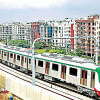What is mass rapid transit?

The much-anticipated Dhaka Metro Mass Rapid Transit System is due its official launch on December 28. The initial line only runs to and from the Agargaon from Uttara areas of Dhaka in the Line-6 route, but there are plans in motion to open additional lines from next year. While this is the first mass rapid transit in Bangladesh, this transportation system has been used worldwide for many years. As we await the public release of this brand new form of urban transportation, let's take a look at what a mass rapid transit system actually is and what it is like in other countries.
What it is
The term 'rapid transit' or 'mass rapid transit' refers to heavy-rail train-like transports meant to support high-capacity urban travel. In other places around the world, 'mass rapid transit' (MRT) also consists of subways or underground trains, with the same purpose of allowing urban citizens an easy and effective way to travel around busy cities.
The emphasis on the 'mass' term indicates that an MRT transport must be capable of carrying a large number of travellers, as opposed to smaller numbers supported by other urban rail-based transports such as trams and monorails.
In an MRT system, the rail tracks are either laid within underground tunnels or on viaducts that are elevated above the street levels when running through a city. Furthermore, an MRT transport is almost always electric - meaning that it runs on electricity and does not rely on gas or other non-renewable sources of energy.
Purpose
The primary purpose of an MRT system is to ease traffic congestion in populated cities, especially the capitals. As the rail lines are separated from the rest of the traffic on the busy roads, MRT transports offer a time-efficient system of getting around a big city.
Additionally, being an electric-run system, MRT transports are environmentally friendly as they do not release greenhouse gases like commuter vehicles such as cars and buses. As such, they are a great way of reducing strain on the environment and ensuring cleanliness.
MRT in Bangladesh
According to the official Dhaka Mass Transit Company Limited (DMTCL) website, the Dhaka Metro Mass Rapid Transit System will consist of 6 lines, which will cover about 128 kilometres in total.
The soon-to-be-launched first phase of MRT Line-6 will cover 11.73 kilometres via its dedicated elevated viaducts from Uttara to Agargaon. The remaining 8 kilometres planned for MRT Line-6 Phase 2 is expected to be in operation by December 2023, and is planned to run from Agargaon to Mothijheel. By June 2025, an additional one kilometre line is planned to be added, which will run from Mothijheel to Kamalapur.
As per plans by DMTCL, MRT Line-6 will have a total of 16 stations, all of which will be elevated as well. Upon completion, all six lines of the Dhaka metro rail are planned to consist of a total of 104 stations across Dhaka.
MRT in other countries
The first-ever instance of what we now know as the mass rapid transit system stems back to 1863 in London, England. Initially running as a circular train in a central London-based subway, the transit system expanded to other parts of London in 1904. Currently, it is considered an essential part of what locals call the 'London Underground' or 'The Tube'.
The first Asian country to properly incorporate the MRT system was Japan. Back in 1927, the land of the rising sun opened Asia's first subway system in its capital, Tokyo. Soon, the service expanded to other parts of Japan, including Osaka, Yokohama and Kyoto.
Continuing in Asia, the country with the largest MRT system in the world is China, with its 800+ km long Shanghai Metro system. However, the New York Subway is the largest in terms of stations - currently operating in 468 stations and 24 lines, mostly situated in the massive city's underground tunnels.
There are currently about 15 launched metro rail projects in India covering about 800 km of operational line, with many projects in development phases or awaiting full launches. Delhi Metro, with over 340 km of operational line, is the largest metro system in India.

 For all latest news, follow The Daily Star's Google News channel.
For all latest news, follow The Daily Star's Google News channel. 







Comments